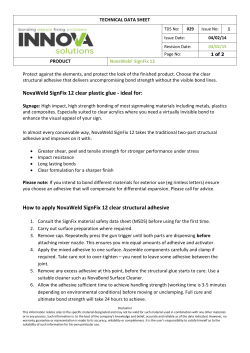
WP111SBD SuperBond Adhesive Highlights Printing
Product Information Bulletin WP111SBD SuperBond Adhesive Wilflex SuperBond Adhesive is a specially formulated hot-peel/hot-split plastisol transfer adhesive. Super Bond Adhesive will create transfers that have excellent durability, stretch and wash properties onto fabrics that are not totally conditioned for regular hot-split plastisol transfer inks. Highlights Compliant with CPSIA (Consumer Product Safety Improvement Act) 2008 Section 101, Lead Content in Substrates (<300 ppm lead); 16 CFR, Part 1303, Lead in Paint (<90 ppm lead). Excellent abrasion and crack resistance. Superior Adhesion. Maximum elongation. Can be used as a foil adhesive for direct printing. Printing Parameters Opacity Bleed Resistance Smooth Surface Flash Gloss Printability n/a n/a 9 8 n/a 9 Fabric Types 100 % Cotton, cotton blends, rayon, linen, uncoated nylon, and lycra. Mesh Counts: 86-156 t/in (34-61 t/cm) recommended Tension: 25-35 n/cm² recommended Squeegee Adjustments to the drying mechanism may be required as the variables of different drying (heat) types, length of dryer conveyor and drying units, will affect the overall transfer finish. The majority of standard transfer papers can be used with confidence. If a softer-feel transfer is required, an uncoated transfer paper is recommended. In most cases, a hotsplit/hot-peel transfer paper will be required. Preprint, transfer and test all fabrics for desired properties before beginning production printing. Precautions Perform fusion tests before production. Failure to cure ink properly may result in poor wash fastness, inferior adhesion and unacceptable durability. Ink gel and cure temperatures should be measured using a Thermoprobe placed directly in the wet ink film and verified on the production run substrate(s) and production equipment. It is the responsibility of the printer to determine that the correct ink has been selected for a specific substrate and the application processes meet your customer’s standards or specifications. Turn the garment inside-out when washing and drying to keep the transfer looking its best. Examine the fabric type and color before and after the application of the transfer, as color distortion may occur due to the introduction of heat to sensitive fabric types and dyestuffs inherent in the garment. It is advisable to press the blank shirt under transfer press before applying transfer to reduce moisture in garment. Stir plastisols prior to printing. Do not dry clean, bleach or iron the printed area. Email: techserviceswilflex@polyone.com Stencil Direct: 2 over 2 Capillary/ thick film: 200-400 micron Off contact: 1/16” (.2 cm) Gel/Cure Temperatures Gel: 220-260 F (104-127 C). Lower temps will result in a transfer with little tensile strength, and higher temps will negatively affect the “split” of the final transfer. Cure: 375 F (190 C) entire film Pigment Loading MX: EQs: PCs: N/A N/A 10% max by weight Additives Extender: None Reducer: None Storage 65°-90°F (18°-32°C) Avoid direct sun. Use within one year of receipt. Clean Up Wilflex screen wash Health & Safety MSDS: www.polyone.com ® Wilflex™ inks by PolyOne. www.wilflex.com/pib ©2009 PolyOne Corporation All Rights Reserved. Effective 5/05/2009. Not all Wilflex products are available in every country. The information in this publication is based on information and experience believed reliable. Since many factors may affect processing for an application, processors must carry out their own tests and experiments to confirm suitability for intended use. You must make your own determination of suitability for your intended use and environmental acceptability, the safety and health of your employees, and purchasers of your product. 5.2009 :: c0040 Durometer: 60-80 Edge: Hard, square Stroke: Hard flood, slow speed Avoid excess pressure. Wilflex SuperBond Adhesive Printing Tips
© Copyright 2025





















